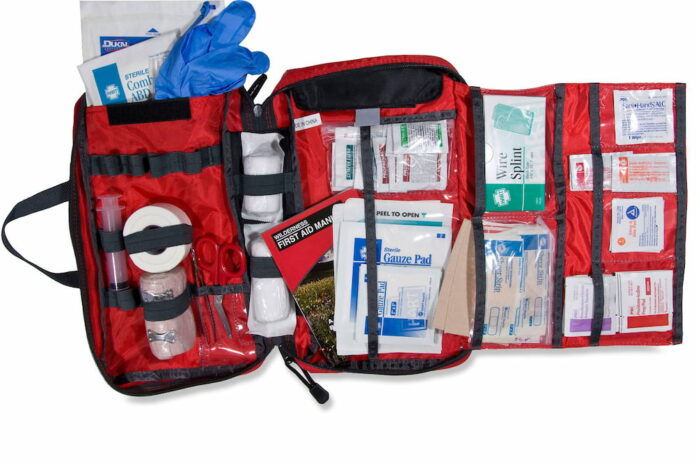An emergency may arise at any time and anywhere, and one should have to respond quickly in such a situation to prevent any damage to lives or surroundings. A first aid emergency is one example which requires individuals to be familiar with first aid and be prepared for it so they know what to do for different types of injuries.
A well-stocked first aid kit can help overcome common injuries or emergencies on time until professional help arrives at the location.
This content piece, therefore, will explore a wide list of first aid supplies one needs to have in an emergency for different types of environments including homes, travel, or at work.
Types of Injuries or Accidents that Require First Aid
Thousands of people die or get seriously injured every year due to various accidents, injuries, or incidents at work, home, or anywhere else. Many of these injuries require immediate attention so that the risk of fatalities can be mitigated.
Some of these common accidents or emergencies to occur are:
- Bleeding
- Cuts & burns
- Choking
- Drowning
- Shock
- Strokes
- Heart attacks
- Fractures
- Electric shocks
- Abrasions
- Stings
- Strains
- Sprains
- Splinters, and more
First Aid Kits Required for Different Scenarios
Let us have a look at different environments and scenarios and what type of first aid kits and supplies are needed.
First Aid Kit – Travel
While traveling, it is important to have a first aid kit that needs be more comprehensive for the reason that a medical store may or may not be accessible.
The kit should contain items to treat ailments like fever, respiratory infection, nausea, sore throat, cuts, gastrointestinal problems, wounds, allergies, or other medical emergencies.
So, a first kit for traveling must have the following:
- Adhesive tape
- Sterilize gauze pad
- Antacid for indigestion
- Antidiarrheal
- Antihistamine cream to treat itchiness or allergies
- Antiseptic agent to treat or clean wounds, cuts, or hands
- Painkillers like aspirins to treat mild pain or heart attack
- Adhesive bandage
- Oral antihistamine to treat motion sickness
- Cough medication
- Dental kit to treat any dental issues
- Cigarette lighter to sterilize instruments or to start a fire
- Insect repellent
- Knife
- Ointment to prevent blisters
- Nasal spray decongestant to treat colds or allergies
- Oral decongestants
- Personal medications
- Plastic resealable bags
- Pocket mask for CRP
- Scissors
- Thermometer
- Tweezers
- Sunscreen
- Antibiotic ointment and the list go on
First Aid Kit – At-home
While talking about first aid supplies at home, one should have the followings:
- Adhesive tape
- Ace bandage to wrap sprained joints
- Adhesive bandage
- Antiesthetic spray
- Exam gloves
- Antibiotic cream to apply to simple wounds
- Non-adhesive pads to cover wounds
- Safety pins
- Tweezers
- Scissors
- Resealable bags
- Pocket masks for CRP
- Ointments for treating various allergies or itchiness
First Aid Kit – In the Workplace
While in the workplace, a comprehensive first aid kit must include:
- Plasters to treat small cuts or grazes
- Dressings to stop bleeding
- Bandage to hold dressings in place or to put pressure on wounds
- Disposable gloves to minimize the risk of infection
- Face shields or pocket masks
- Cleansing or alcohol-free wipes to clean skin around the wounds
- Foil blankets to help retain body heat in emergency
- Triangular bandage
- Skin rash cream
- Spray or cream to treat insect bites
- Eyewash or eye bath
- Distilled water to clean wounds or cuts
Where First Aid Kits Must be Located?
The above-mentioned list must have given enough information on what first aid supplies must be needed in various environments. With that being said, one must ensure that they know how to properly use a first aid box when in need. And so, must know the best location to keep it.
While in homes, the ideal place to keep the first aid box is in the kitchen, so that it is easily accessible to everyone in an emergency. While traveling, it is best to keep it in a suitcase or a bag pack to be reached easily.
When talking about first aid kit located in the workplace, employers should keep them in a place where it is easily accessible and visible to everyone or anyone in need to help the affected person.
What’s More
Additionally, employers are required to properly train and equip their personnel to respond quickly and proficiently in an emergency. There are numerous options available to do so, for example, first aid at work course or else employers can also arrange on-site training sessions to give a thorough understanding to their staff.
To Wrap it Up
Minor to severe injuries or accidents could arise at any time and any place, the best preparation to prevent them is to have proper arrangements to overcome the issue before it creates a problem for people and their surroundings. Therefore, individuals need to be aware of first aid supplies they can get their hands on in an emergency, and this post has covered some of these.
Read Also
- Why comprehensive health insurance with maternity is beneficial in the UAEWelcoming a child is a significant milestone in any family’s journey. As exciting as this chapter is, it also brings with it a fair share of responsibilities—especially when it comes to planning for healthcare costs. Health insurance is now mandatory in the UAE, but as with any type of insurance, the smallest requirement might not… Read more: Why comprehensive health insurance with maternity is beneficial in the UAE
- Modern Approaches to Adolescent Mental Health Treatment for Lasting RecoveryWith increasing numbers of teens experiencing emotional and behavioral health concerns, adolescent mental health treatment has become more essential than ever. Conditions such as anxiety, depression, trauma and mood instability are on the rise, and effective support must evolve with these growing needs. Today’s treatment models blend evidence-based therapy with flexible access and holistic care, giving… Read more: Modern Approaches to Adolescent Mental Health Treatment for Lasting Recovery



